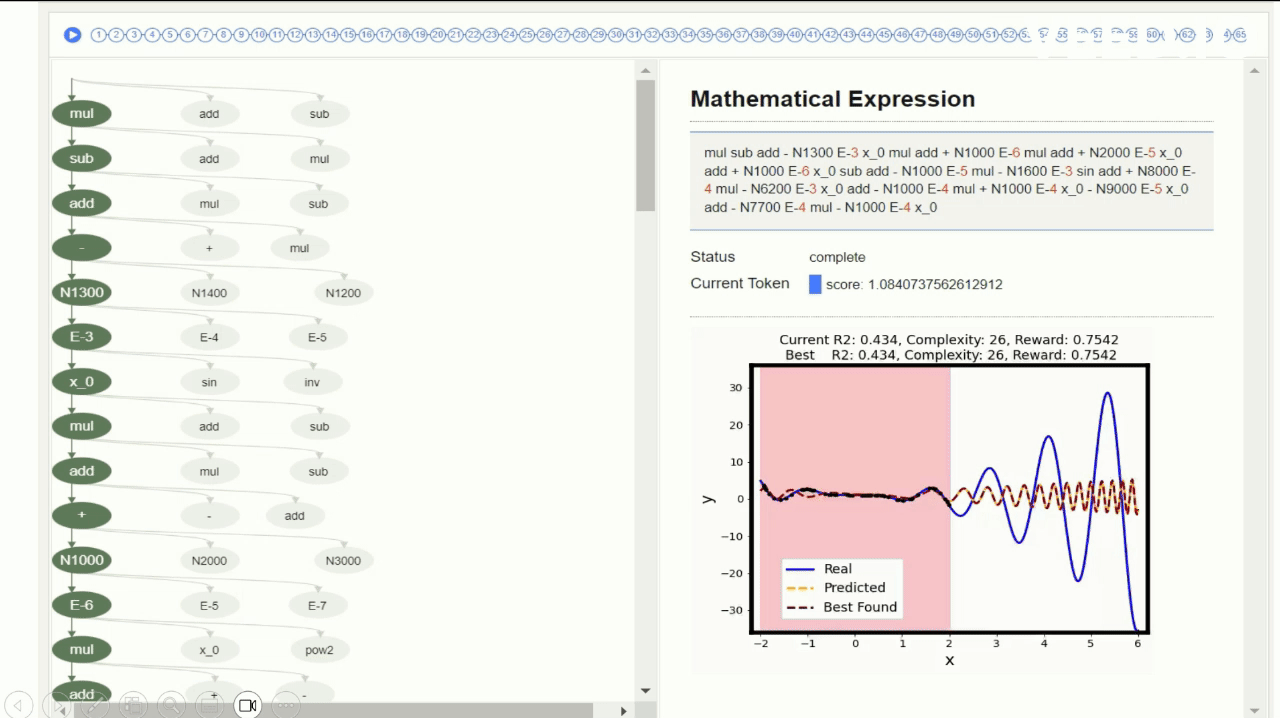Official Implementation of Transformer-based Planning for Symbolic Regression (NeurIPS 2023).
In this paper, we introduce TPSR, a novel transformer-based planning framework for symbolic regression by leveraging priors of large-scale pretrained models and incorporating lookahead planning. TPSR incorporates Monte Carlo Tree Search (MCTS) into the transformer decoding process of symbolic regression models. Unlike conventional decoding strategies, TPSR enables the integration of non-differentiable feedback, such as fitting accuracy and complexity, as external sources of knowledge into the transformer-based equation generation process.

TPSR uncovering the governing symbolic mathematics of data, providing enhanced extrapolation capabilities.
- Download Pre-trained Models:
After downloading, extract both models to this directory. They should be located under the symbolicregression/weights/ and nesymres/weights/ sub-folders, respectively.
- Download Benchmark Datasets:
- Feynman equations are here
- PMLB datasets are also here. Data points of PMLB datasets are used in the SRBench (A Living Benchmark for Symbolic Regression), containing three data groups: Feynman, Strogatz, and Black-box.
Extract the datasets to this directory, Feynman datasets should be in datasets/feynman/, and PMLB datasets should be in datasets/pmlb/.
To run the code with deafult E2E backbone model, create a conda environment and install the dependencies by running the following command.
conda create --name tpsr
conda activate tpsr
pip install -r requirements.txt
If you're interested to run experiments with NeSymReS backbone, install its additional dependencies from here. You can follow these steps:
conda create --name tpsr
conda activate tpsr
cd nesymres
pip install -e src/
pip install -r requirements.txt
pip install lightning==1.9
We have created run.sh script to execute Transformer-based Planning for Automated Equation Discovery based on the reward defined in reward.py with the combination of equation's fitting accuracy and complexity. To run the script for different datasets, configure the following parameters:
| Parameters | Description | Example Values |
|---|---|---|
backbone_model |
Backbone Pre-trained Model Type (e2e/nesymres) | e2e |
eval_in_domain |
Evaluate backbone pre-trained model on In-Domain dataset (Yes/No) | True/False |
eval_mcts_in_domain |
Evaluate TPSR on In-Domain dataset (Yes/No) | True/False |
eval_on_pmlb |
Evaluate backbone pre-trained model on PMLB (Yes/No) | True/False |
eval_mcts_on_pmlb |
Evaluate TPSR on PMLB (Yes/No) | True/False |
horizon |
Horizon of lookahead planning (maxlen of equation tokens) | 200 |
rollout |
Number of rollouts ( |
3 |
num_beams |
Beam size ( |
1 |
width |
Top-k ( |
3 |
no_seq_cache |
Use sequence caching (Yes/No) | False |
no_prefix_cache |
Use top-k caching (Yes/No) | False |
ucb_constant |
Exploration weight in UCB | 1.0 |
uct_alg |
UCT algorithm |
uct |
max_input_points |
Maximum input points observed by pre-trained model ( |
200 |
max_number_bags |
Maximum number of bags for input points ( |
10 |
pmlb_data_type |
PMLB data group |
feynman |
target_noise |
Target noise added to y_to_fit in PMLB | 0.0 |
beam_type |
Decoding type for pre-trained models |
sampling |
beam_size |
Decoding size ( |
10 |
n_trees_to_refine |
Number of refinements in decodings |
10 |
prediction_sigmas |
Sigmas of extrapolation eval data sampling (In-domain) | 1,2,4,8,16 |
eval_input_length_modulo |
Number of eval points (In-domain). Set to 50 yields |
50 |
Pre-trained E2E Model (Sampling / Beam Search):
python run.py --eval_on_pmlb True \
--pmlb_data_type feynman \
--target_noise 0.0 \
--beam_type sampling \ # or search
--beam_size 10 \
--n_trees_to_refine 10 \
--max_input_points 200 \
--max_number_bags 10 \
--save_results True
Transformer-based Planning with E2E Backbone:
python run.py --eval_mcts_on_pmlb True \
--pmlb_data_type feynman \
--target_noise 0.0 \
--lam 0.1 \
--horizon 200 \
--width 3 \
--num_beams 1 \
--rollout 3 \
--no_seq_cache False \
--no_prefix_cache True \
--max_input_points 200 \
--max_number_bags 10 \
--save_results True
For running the code on Strogatz or Black-box datasets, simply adjust the pmlb_data_type parameter to either strogatz or blackbox. The commands provided above are set for the Feynman datasets. You can also modify the target_noise and other parameters to suit your experiments. Running each command saves the results for all datasets and metrics in a .csv file.
In-Domain datasets are generated, following the validation data gneration protocol suggested in E2E. For details, refer to the generate_datapoints function here. You can also modify data generation parameters here. For example, you can adjust parameters like prediction_sigmas to control extrapolation. A sigma 1 aligns with the training data range, while >1 is for extrapolation ranges. The In-domain validation datasets are generated on-the-fly. For consistent evaluations across models, consider setting a fixed seed.
Pre-trained E2E Model (Sampling / Beam Search):
python run.py --eval_in_domain True \
--beam_type sampling \ # or search
--beam_size 10 \
--n_trees_to_refine 10 \
--max_input_points 200 \
--eval_input_length_modulo 50 \
--prediction_sigmas 1,2,4,8,16 \
--save_results True
Transformer-based Planning with E2E Backbone:
python run.py --eval_mcts_in_domain True \
--lam 0.1 \
--horizon 200 \
--width 3 \
--num_beams 1 \
--rollout 3 \
--no_seq_cache False \
--no_prefix_cache True \
--max_input_points 200 \
--eval_input_length_modulo 50 \
--prediction_sigmas 1,2,4,8,16 \
--save_results True \
--debug
We have also included a small demo that runs TPSR with both E2E and NesymReS backbones on your dataset. You can play with it here
E2E+TPSR:
python tpsr_demo.py --backbone_model e2e --no_seq_cache True --no_prefix_cache True
NeSymReS+TPSR:
python tpsr_demo.py --backbone_model nesymres --no_seq_cache True --no_prefix_cache True
If you find the paper or the repo helpful, please cite it with
@inproceedings{
tpsr2023,
title={Transformer-based Planning for Symbolic Regression},
author={Parshin Shojaee and Kazem Meidani and Amir Barati Farimani and Chandan K. Reddy},
booktitle={Thirty-seventh Conference on Neural Information Processing Systems},
year={2023},
url={https://openreview.net/forum?id=0rVXQEeFEL}
}
This repository is licensed under MIT licence.
This work is built on top of other open source projects, including End-to-End Symbolic Regression with Transformers (E2E), Neural Symbolic Regression that scales (NeSymReS), Dyna Gym, and transformers. We thank the original contributors of these works for open-sourcing their valuable source codes.
For any questions or issues, you are welcome to open an issue in this repo, or contact us at parshinshojaee@vt.edu, and mmeidani@andrew.cmu.edu .